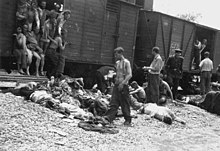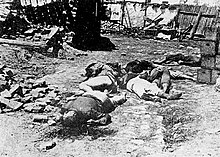The Holocaust in Romania

The Holocaust in Romania was the development of the Holocaust in the Kingdom of Romania. 380,000–400,000 Jews died in Romanian-controlled areas, including Bessarabia, Bukovina and Transnistria.[1] Romania ranks first among Holocaust perpetrator countries other than Nazi Germany.[2][3][4]
Background
In the first decades of the 20th century,
Pre-war government policies and legislation

In Romania, antisemitic legislation was not an attempt to placate the Germans, but rather entirely home-grown, preceding German hegemony and Nazi Germany itself. The ascendance of Germany enabled Romania to disregard the minorities treaties that were imposed upon the country after the First World War. Antisemitic legislation in Romania was usually aimed at exploiting Jews rather than humiliating them as in Germany.[7]
At the end of 1937, the government of Octavian Goga came to power, Romania thus becoming the second overtly antisemitic state in Europe.[8][9] Romania was the second country in Europe after Germany to enact antisemitic legislation, and the only one besides Germany to do so before the 1938 Anschluss.[10][11] Romania was the only country other than Germany itself which "implemented all the steps of the destruction process, from definitions to killings."[12][13]
Anti-Jewish violence and deportations


The Romanian Holocaust was outside the control of the Nazis. Its beginning did not require Nazi intervention, Romania being the only ally of the Third Reich that carried out its genocidal campaign without the intervention of
See also
- Antisemitism in Romania
- Deportations of Romani people to Transnistria
- Post-World War II Romanian war crime trials
References
- ^ "Murder of the Jews of Romania". www.yadvashem.org. Archived from the original on 6 February 2022. Retrieved 23 February 2022.
- ISBN 9781139500777– via Google Books.
- ^ Valeria Chelaru: Tradition, Nationalism and Holocaust Memory: Reassessing Antisemitism in Post-Communist Romania, page 73
- ^ Roland Clark: New models, new questions: historiographical approaches to the Romanian Holocaust, page 304
- ^ Lucian Tudor: The Romanian Iron Guard: Its Origins, History, and Legacy, page 69
- ^ Lucian Tudor: The Romanian Iron Guard: Its Origins, History, and Legacy, pages 70-79
- ISBN 9783319398020– via Google Books.
- ISBN 9780521774789– via Google Books.
- ISBN 9781538138090– via Google Books.
- ^ Weinbaum, Laurence (31 January 2004). "Where Memory is a Curse and Amnesia a Blessing: A Journey Through Romania's Holocaust Narrative". Institute of the World Jewish Congress – via Google Books.
- ISBN 9789639241527– via Google Books.
- ISBN 9780691205250– via Google Books.
- ISBN 9780802058614– via Google Books.
- ^ Henry Eaton, Wayne State University Press, May 2013, The Origins and Onset of the Romanian Holocaust
- ^ Stanley G. Payne, University of Wisconsin Pres, Jan 1, 1996, A History of Fascism, 1914–1945, p. 396
- ^ Ion Popa, Indiana University Press, Sep 11, 2017, The Romanian Orthodox Church and the Holocaust, p. 30
- ^ Maksim Goldenshteyn, University of Oklahoma Press, Jan 20, 2022, So They Remember: A Jewish Family’s Story of Surviving the Holocaust in Soviet Ukraine, p. 8
